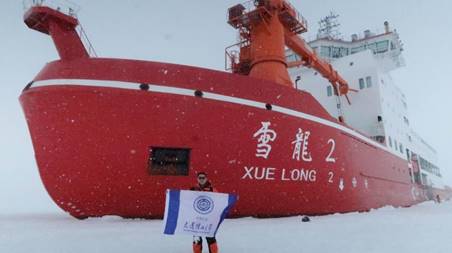Date:Jan 21, 2020
Source: Faculty of Infrastructure Engineering
By Li Xiang
A few days ago, the first phase of China’s 36th Antarctic Scientific Expedition was successfully completed. China’s first domestically-built polar research vessel and icebreaker Xuelong 2 completed the ice breaking performance experiment in the Prydz Bay area of the Antarctic Ocean. Wang Qingkai, the head of the ice test team for this experiment, is a postdoctoral student from DUT.

The polar icebreaker Xuelong 2 was independently built by China, and it is designed to be able to continuously break ice at 2 to 3 knots in 1.5m ice and 0.2m snow environment. The ice-breaking experiment needs to verify whether the ice-breaker meets the design standards under natural conditions. As the leader of the ice surface test team, Wang Qingkai was responsible for the field test of the experimental ice layer properties. They conducted the experimental process smoothly and got good results, which provided sufficient scientific data for the verification of the ice-breaking performance of Xuelong 2.
Wang Qingkai is a student of Professor Li Zhijun from the State Key Laboratory of Coastal and Offshore Engineering. They have long been engaged in polar sea ice research, and already participated in 10 Arctic scientific expeditions and 9 Antarctic scientific expeditions organized at home and abroad on behalf of DUT. In addition, they also participated in the European Union’s “Horizon 2020” project. As one of the only three units in China, they conducted research on issues related to Arctic shipping with universities in the UK, Sweden and Finland.
Editor: Li Xiang